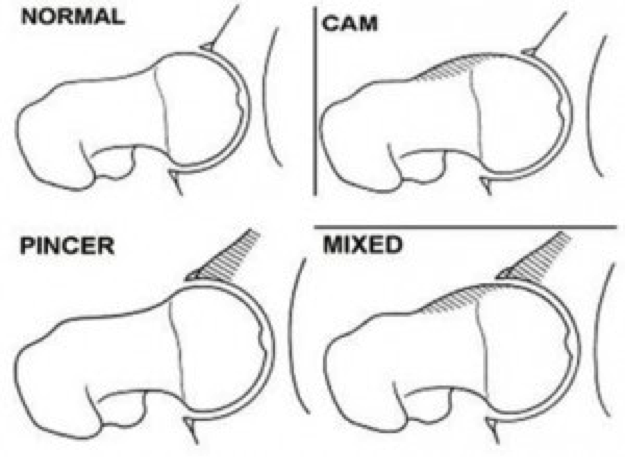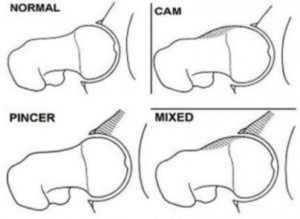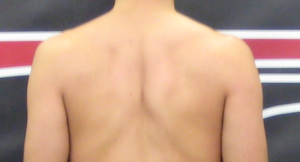
Random Thoughts on Sports Performance Training – Installment 24
With only a few days to spare, here is the November 2016 edition of randomness!
1. Don’t let bad movement become cemented joints.
As I presented in Functional Stability Training of the Upper Body, mobility can be restricted for a lot of reasons.
One thing I didn’t note in this video is that if you have muscular, capsular, or alignment issues that persist for an extended period of time, you’ll eventually develop changes to the joint (bony overgrowth). In a 2013 study, world-renowned hip specialist Marc Phillipon examined how the incidence of femoroacetabular impingment (FAI) – bony overgrowth at the hip – changed across various stages of youth hockey. At the PeeWee (10-12 years old) level, 37% had FAI and 48% had labral tears. These numbers went to 63% and 63% at the Bantam level (ages 13-15), and 93% and 93% at the Midget (ages 16-19) levels, respectively. The longer one played hockey, the messier the hip – and the greater the likelihood that the FAI would “chew up” the labrum.

Source: Lavigne et al. 2004
It’s imperative for strength and conditioning coaches to understand these issues. On evaluation, if an athlete already has changes to the joint, we need to create training programs to deliver a training effect while working around these issues. If you squat an entire team of football players even though you know 4-5 of them already have significant FAI and associated pathologies in their hips, you’re probably going to be funding some hip surgeon’s retirement. Work on deadlifting and single-leg work instead, though, and you’ll probably kick the can down the road for those athletes.
Conversely, if your assessment reveals that an athlete is out of alignment and has some tissue density and core control issues that are preventing quality hip flexion and internal rotation, you need to design a program to get to work on those problems before they can develop bony blocks at the hip. As my buddy Mike Reinold often says, “Assess, don’t guess.”
2. We might be seeing the end of the versatile strength and conditioning coach.
One thing I’ve noticed in the strength and conditioning field over the past decade is an increased tendency toward specialization among coaches. Over the years, there have some been really bright coaches – Al Vermeil, Mike Boyle, and Bob Alejo come to mind – who’ve had success across multiple sports at the highest levels. They were few and far between, but it was still something that was feasible if someone was educated and motivated enough. I think that’s changing and this versatility will be obsolete very soon.
We’re seeing a much bigger focus on analytics in all professional sports; the focus on minute details has never been greater. In college sports, we are seeing more “baseball only” and “hockey only” guys to build on the years of the football strength and conditioning coach typically not working with other teams. At every level, specialization among strength coaches (and rehabilitation specialists, for that matter) is increasing. As a result, if a coach tries to venture out into another sport at a high level, it takes longer to get up to speed.
If a guy leaves basketball to go to baseball, he’s got to learn about thoracic outlet syndrome, ulnar collateral ligament injuries, and lat strains; these just don’t happen very often in hoops. He won’t have to worry much about humeral retroversion in his programming for shooting guards, either – but it has a huge influence on how he manages functional mobility in pitchers.
Likewise, just because I have a solid handle on managing shoulders in overhead athletes doesn’t mean that I’m equipped to handle the metabolic demands that swimmers encounter.
Versatility is still important; a well-rounded professional will never go hungry. However, at the higher levels, I just see fewer and fewer professional teams and colleges valuing it highly when the quickest option is to seek out specialists in specific realms.
3. Create context not only to improve coaching, but also to improve adherence.
Recently, I saw a professional pitcher who noted that his team had commented on how limited his extension on each pitch was. For those who aren’t familiar, in recent years, teams have started tracking the actual release point of various pitchers. Basically, if two pitchers both throw 95mph, but one releases the ball closer to the plate, the one with more extension is actually releasing the ball closer to the plate, so it “gets on” the hitter faster. All things considered, a higher extension is generally better. You can view it as part of the Statcast panel on each MLB pitchers’ page; here’s CSP athlete Steve Cishek’s, as a frame of reference. Steve’s extension is well above MLB average, so the perceived velocity of his pitches are over one mph higher than their actual velocity.
![]()
Returning to the pitcher I evaluated recently, he commented that although his fastball velocity is among the best in the minor leagues and he has quite a bit of movement, he doesn’t strike a lot of guys out. While there are a lot of reasons for this, one consideration has to be physical limitations that don’t allow him to get extension out in front. In his case, on evaluation, we saw a pseudo military posture; his shoulder blades were tugged back into adduction, and he lacked the upward rotation to effectively “get out front.”

Additionally, in the lower extremity, he had significant bilateral muscular/alignment limitations to hip internal rotation. If you don’t have sufficient hip internal rotation on your back leg, you aren’t going to ride your hip down the mound very far. If you don’t have internal rotation on the front hip, you won’t be able to accept force on the front leg, so you’ll effectively cut off your deceleration arc, also shortening your extension out front. These are usually the guys who “miss” up-and-armside, or cut balls off in an attempt to correct the issue.
If I had just told him he needed to fix these for the sake of fixing them – or even just to prevent injury – it probably wouldn’t hold much water. However, by relating these movement inefficiencies back to aspects of his delivery with which he struggles, the buy-in is a lot higher. Striking guys out is a lot “sexier” than avoiding injury or conforming to some range-of-motion norm.
4. This is a great weekend to be an up-and-coming fitness professional or rehabilitation specialist on a limited budget.
Black Friday/Cyber Monday might be annoying if you’re in stores and dealing with a bunch of crazy Moms who are fighting over the last Tickle-Me-Elmo, but in an online context, it’s pretty darn awesome – especially if you’re an aspiring coach looking to get your hands on some quality educational material.
I did my undergraduate education at a smaller Division 3 school in Southern Maine. We didn’t have a varsity weight room where I could observe or volunteer, and there weren’t tip top internship opportunities right down the road where I could’ve found opportunities like that. Looking back, I realize that one of the main reasons I got on the right path was that I was willing to search high and low for those learning opportunities. I spent hours reading T-Nation and hard copy books I’d bought, not to mention driving to whatever seminars I could find.
Nowadays, education is much, more more accessible. Instead of driving nine hours to Buffalo or dropping $1,000 on a plane right, hotel, rental car, and seminar registration, you can spend 10% of that amount and get an awesome education – and you can pick and choose what you want to learn. This weekend, you can do it super affordably, too.
Want a crash course in relative stiffness? Check out my presentations in Functional Stability Training: Optimizing Movement (on sale for 20% off with coupon code BF2016).
Looking to patch up the holes in your college anatomy course by learning about functional anatomy instead? Pick up Building the Efficient Athlete from Mike Robertson and me (20% off this weekend; no coupon code needed).
Need some cutting-edge hip mobility strategies? Watch Dean Somerset’s presentations in The Complete Shoulder and Hip Blueprint (on sale for $30 off through Monday).
Interested in taking a peek into the mind of a successful NFL strength and conditioning coach? Soak up Joe Kenn’s knowledge in Elite Athletic Development (20% off this weekend; no coupon code needed).
It’s an amazing age in strength and conditioning; short of actual hands-on coaching experience, all the information you need to be successful is at your fingertips in a digital medium – and this is the weekend to get it at the best price.


